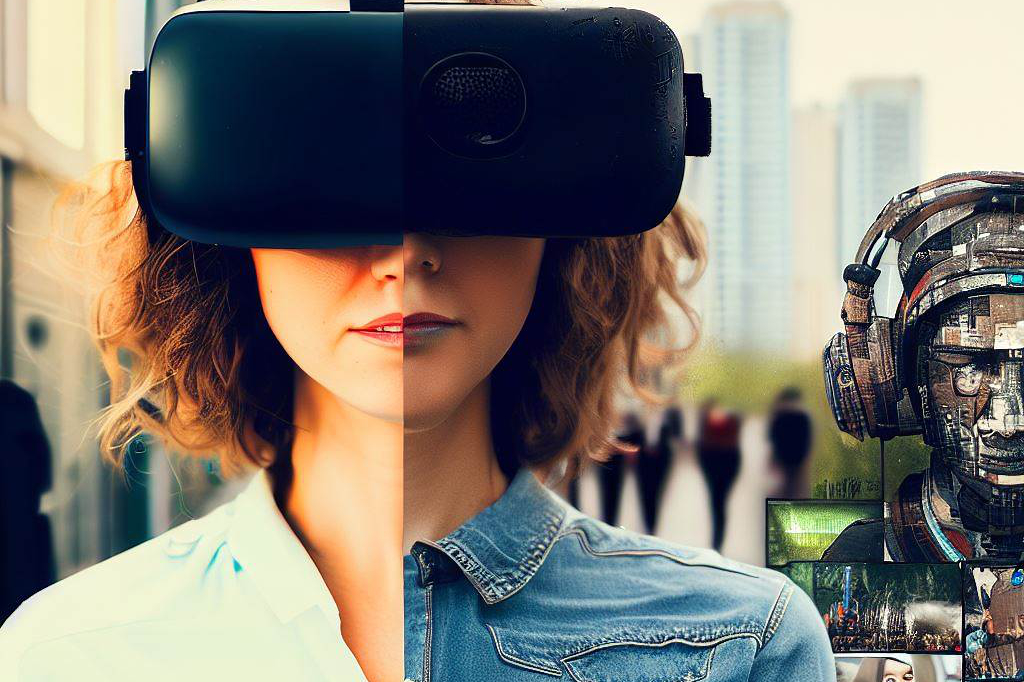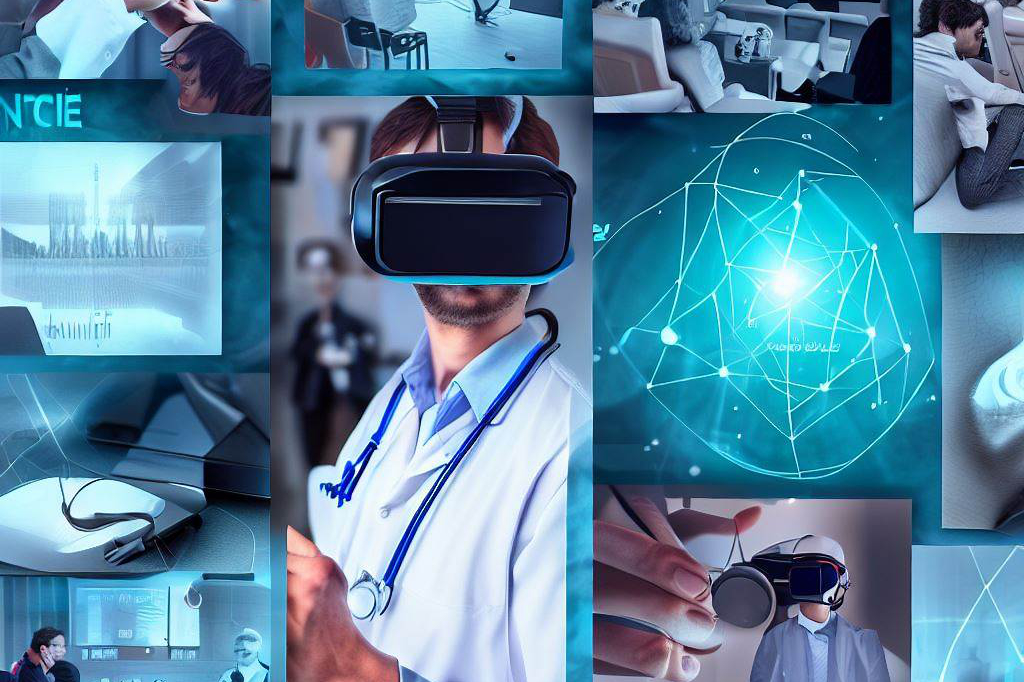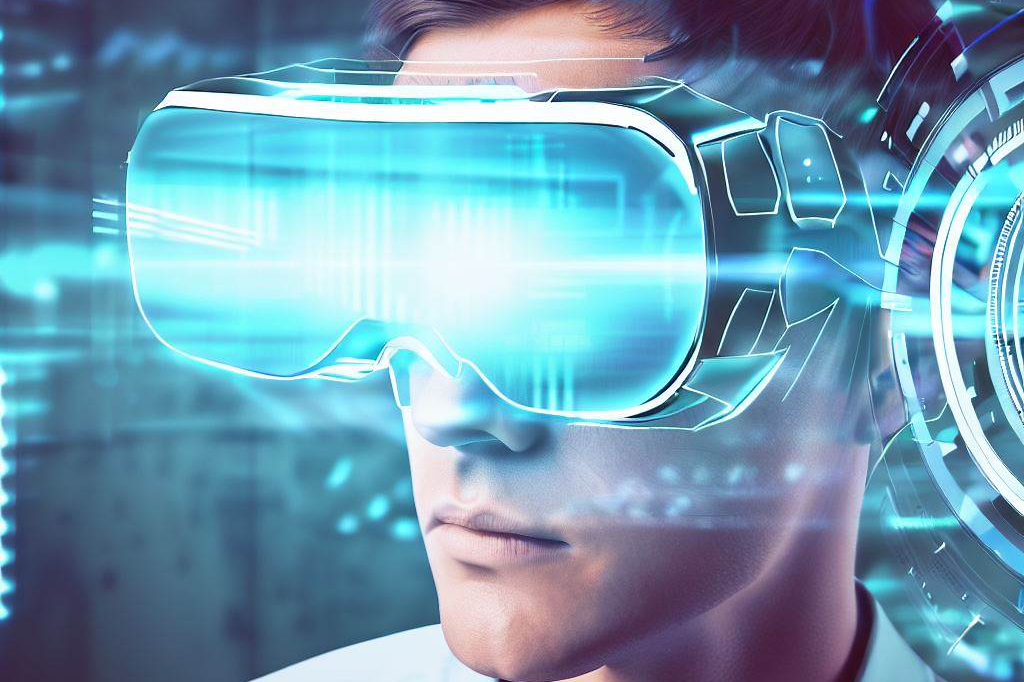Are you ready to step into a world where reality and technology collide? Augmented Reality, or AR for short, is a rapidly growing field that has the potential to revolutionize the way we interact with our environment.
With AR, digital information is superimposed on the physical world around us, creating an entirely new experience. At its core, AR blends our perceptions of what is real and what is not.
It takes cues from the physical world and enhances them with digital elements such as images, videos, or 3D models. This technology has already begun to make waves in industries ranging from entertainment to education and beyond.
The Basics of Augmented Reality
Before diving deeper into the intricacies of AR and how it impacts our perception of reality, let’s first take a quick look at what this technology actually is. Simply put, Augmented Reality overlays digital content onto the real world through a device such as a smartphone, tablet, or headset.
The concept of AR dates back several decades, but it wasn’t until recently that advances in technology allowed for more seamless integration between the physical and digital worlds. Today, we see AR being used in various applications such as gaming, advertising, retail, and even medicine.
A New Kind of Experience

So why has augmented reality become so popular among developers? It’s because it offers something truly unique – an immersive experience that blends both virtual and real-world elements together.
With augmented reality technology, we can explore places without physically being there or interact with objects we would not normally be able to see or touch. AR has also given rise to new possibilities for storytelling, allowing creators to craft interactive narratives that take place in both fictional worlds and our own.
For example, Pokemon Go brought young people out of their homes and into neighborhoods, searching for pocket monsters hidden through their phone screens. As we move forward into an increasingly digitized world, it’s clear that augmented reality technology will continue to play a significant role in redefining our perception of reality.
How does AR technology work?
AR uses devices such as smartphones, tablets, headsets or glasses to display digital information in real-time. The device’s camera captures the view of the user’s surroundings and displays enhanced information on top of it. This process requires advanced computer vision algorithms that can recognize and track objects in real-time, providing users with an interactive experience.
Examples of AR applications in various industries
AR technology has been adopted by many industries to enhance their products and services. For instance:
- Retail: ar applications have revolutionized online shopping by allowing customers to try on clothes or view furniture before making a purchase online.
- Gaming: games like pokemon go use ar technology to create interactive gameplay by overlaying fictional characters onto the player’s surroundings.
- E-commerce: companies like ikea have developed ar apps that let customers view how furniture would look in their homes before making a purchase.
- Education: ar technology is being used in classrooms to create immersive learning experiences for students across various subjects from history to science.
- Sports: broadcasters are using augmented reality graphics during live sports events for match analysis and engaging viewers with game statistics.
Augmented Reality has become a popular technology that blurs the line between the physical and digital worlds. It provides an enriched experience for users and has many practical applications in various industries. The rapid development of AR technology is expected to continue, leading to more innovative augmented experiences in the future.
The Impact of AR on Our Perception of Reality

Blurring the lines between physical and digital worlds
One of the most significant impacts that Augmented Reality has on our perception of reality is how it blurs the boundaries between the physical and digital worlds. In the past, we have always thought of these as two separate entities – you were either in one or the other.
However, with AR technology, we can now merge these two realities together to create a hybrid experience that feels incredibly real. Imagine walking down a street and seeing virtual shops and objects overlaid on the real world around you.
Or being able to manipulate digital objects as if they were right in front of you. This merging of realities can be both exciting and disorienting for users, especially as our brains struggle to adjust to this new mode of perception.
Altering our perception of space and time
AR technology also has significant implications for how we perceive space and time. With AR, we can interact with virtual objects that appear to exist in real-world environments.
This ability makes it possible for us to experience spatial dimensions that would otherwise be impossible or impractical. For example, imagine being able to explore an entire city without ever leaving your living room – an experience made possible through AR technology.
Additionally, AR can alter our sense of time by enabling us to interact with objects from different eras or locations simultaneously. These new modes of perception can be both thrilling and unsettling, as they challenge many conventional beliefs about what is possible in our reality.
The psychological effects of using AR technology
The psychological effects of using Augmented Reality are still being studied, but initial research suggests that it has significant implications for how we think about ourselves and our environment. One study found that people who used AR technology reported feeling more confident and competent than those who did not use it. Additionally, AR experiences have been shown to promote creativity and innovation by encouraging users to think outside the box and explore new possibilities.
However, there are also concerns about the potential negative psychological effects of using AR technology. Some experts worry that AR could contribute to feelings of isolation or detachment from reality, especially if users become too reliant on these technologies for their day-to-day experiences.
Overall, it is clear that Augmented Reality has significant implications for how we perceive our reality and ourselves. As this technology continues to evolve, it will be interesting to see how it impacts our lives and what new possibilities it unlocks for human perception.
Blurring Boundaries Between Physical and Digital Worlds

How AR Merges Physical and Digital Elements to Create a New Reality
Augmented Reality technology has the ability to blend the physical and digital worlds seamlessly. With AR, virtual objects can be superimposed onto the real world, creating a new reality that is both immersive and interactive.
This technology allows users to experience things that were previously impossible or difficult to achieve in the physical world. For example, with AR applications, users can visualize how furniture would look in their home before making a purchase.
They can also try on clothes virtually without having to physically go to a store. In the entertainment industry, AR has enabled us to watch live events from any location as if we were there in person.
AR also allows for new forms of storytelling by integrating digital elements into physical environments. For instance, museums can use AR to provide context and additional information about exhibits as visitors walk through galleries.
The Potential Implications for Society as We Rely More on Augmented Experiences
As we become more reliant on augmented experiences, it’s important to consider how this technology may impact our society. One potential implication is that our perception of reality may become distorted.
If we spend too much time in augmented environments, we may begin to lose touch with what is real and what is virtual. Another potential impact is that certain industries could be disrupted by AR technology.
For example, brick-and-mortar retail stores could face significant challenges if customers begin relying heavily on virtual try-on experiences instead of visiting physical stores. Additionally, privacy concerns arise with the use of AR technology since it collects data about user behavior in physical spaces.
It’s important for companies utilizing this technology to ensure they are transparent about their data collection practices and protect user privacy. While Augmented Reality allows us to merge different realities seamlessly, it’s important to consider how this technology impacts our perception of reality and society as a whole.
Niche Applications for Augmented Reality

Medical Training Simulations Using AR Technology
Augmented Reality has become a game changer in the world of medical training. Medical students used to rely on traditional textbooks and classroom lectures, but now they can use AR technology to simulate realistic medical situations. Medical schools around the world are using AR to train their students in a more immersive and engaging way.
One example is the HoloLens mixed reality headset developed by Microsoft. The HoloLens enables medical students to learn anatomy by virtually dissecting human bodies without ever having to step foot into an actual cadaver lab.
The device provides 3D models of human organs and body structures, allowing students to visualize and interact with them in ways that were previously impossible. AR technology is also being used for surgical training.
Surgeons in training can practice procedures using AR headsets before performing them on real patients. This increases their confidence and reduces the risk of errors during surgery.
Educational Uses for Augmented Experiences in Museums, Classrooms, etc.
Augmented Reality has great potential as an educational tool, especially in museums and classrooms. Instead of relying solely on traditional teaching methods, educators can use AR technology to engage students and make learning more interactive.
In museums, visitors can use mobile devices or headsets equipped with AR technology to explore exhibits like never before. They can view additional information about artifacts or see what life was like during a different time period through interactive simulations.
In classrooms, teachers can create augmented experiences that supplement textbook learning. For example, history teachers could take their class on a virtual tour of famous historical sites or landmarks using AR technology.
AR also benefits learners who have difficulty visualizing concepts such as geometry or physics by enabling them to see these concepts brought to life before their eyes. By providing learners with interactive experiences that stimulate multiple senses simultaneously, AR technology is revolutionizing the way we learn.
AR is not just for gaming and entertainment. As we have seen, it has a variety of niche applications that are changing the way we perceive and interact with the world around us.
Medical training simulations and educational uses in museums and classrooms are just a few examples. As AR technology continues to evolve, it will undoubtedly find new use cases across industries.
It has the potential to improve and even save lives, as well as revolutionize the way we learn. The possibilities are endless with Augmented Reality, and its impact on society will only continue to grow in the coming years.
Future Developments in Augmented Reality Technology
The Potential of AR for Entertainment and Gaming
One of the most exciting areas of development in AR is its potential to revolutionize the entertainment and gaming industries. With AR technology, we can create immersive experiences that blend the real world with digital elements.
Imagine attending a concert where your favorite band’s music is playing all around you, while virtual projections of the band members perform right in front of you. Or playing a game where your living room becomes an interactive battlefield, with game characters appearing right before your eyes.
AR for Remote Work and Communication
As remote work continues to become more prevalent, AR technology offers compelling solutions for bridging physical distance. In the future, it may be possible to use AR headsets to attend virtual meetings as if you were sitting in the same room as your colleagues. You could even project a digital version of yourself into a co-worker’s office for impromptu conversations or collaboration sessions.
Predictions for How AR Will Continue to Evolve and Impact Society

AR Will Become More Integrated into Daily Life
As AR technology continues to evolve and improve, it will likely become more integrated into our daily lives. We’ll see increased adoption of wearable devices like smart glasses or contact lenses that enable us to access augmented experiences seamlessly throughout our day.
AR Will Change How We Interact with Our Environment
The potential impact of augmented reality on our environment is significant. By creating new layers of digital information over our physical surroundings, we can gain new insights and perspectives on our world. For example, an app might provide users with historical information about a landmark they’re standing near or give them real-time data about air quality levels in their area.
Ethical Considerations Surrounding the Use of Augmented Experiences
Privacy Concerns with AR Technology
One of the biggest ethical considerations surrounding AR technology is privacy. As we begin to incorporate more and more digital elements into our physical surroundings, there’s a risk that personal data could be collected and used in ways that individuals are not comfortable with.
The Potential for Addiction to Augmented Experiences
Another potential ethical concern is the possibility of addiction to augmented experiences. As AR technology becomes more immersive, there’s a risk that some people may become so attached to these virtual experiences that they withdraw from the real world altogether. Augmented reality is on the cusp of a major revolution, and its potential applications are limited only by our imaginations.
While there are certainly challenges and ethical considerations associated with this technology, it’s clear that the benefits of augmented reality far outweigh the risks. As we continue to explore new ways to blend the physical and digital worlds through AR interfaces, we’re sure to see some truly groundbreaking innovations emerge in the years ahead…
FAQ: Augmented Reality, the Future, and Our Perception of Reality
1. What is Augmented Reality (AR)?
– Augmented Reality (AR) is a technology that enhances our perception of reality by overlaying digital information, such as graphics, images, or videos, onto the real-world environment. It blends virtual elements with the physical world, providing an interactive and immersive experience.
2. How does Augmented Reality work?
– Augmented Reality works by utilizing a combination of technologies, including cameras, sensors, and computer algorithms. The AR device, such as a smartphone or smart glasses, captures the real-world environment and then processes the data to detect and track objects or surfaces. The virtual content is then superimposed onto the real-world view, aligning with the physical elements in real-time.
3. What are the applications of Augmented Reality?
– Augmented Reality has a wide range of applications across various industries. In the retail sector, AR can be used for virtual try-on experiences, allowing customers to visualize how products would look or fit before making a purchase. In education, AR can enhance learning by providing interactive and immersive content. AR also finds applications in gaming, healthcare, architecture, engineering, and many other fields.
4. How is Augmented Reality different from Virtual Reality (VR)?
– While both Augmented Reality and Virtual Reality offer immersive experiences, they differ in their approach. Augmented Reality overlays virtual content onto the real world, allowing users to interact with both virtual and physical elements simultaneously. On the other hand, Virtual Reality creates a completely simulated environment, isolating users from the real world. VR typically requires dedicated headsets or devices, while AR can be experienced through smartphones or glasses.
5. What are the future prospects of Augmented Reality?
– The future of Augmented Reality holds tremendous potential. As technology continues to advance, AR is expected to become more sophisticated, seamless, and integrated into our daily lives. It is likely to revolutionize various industries, such as healthcare, manufacturing, and entertainment. Augmented Reality glasses may become more compact and fashionable, offering users a seamless and hands-free AR experience. The development of 5G networks will also facilitate faster and more reliable AR applications.
6. How can Augmented Reality benefit businesses?
– Augmented Reality can benefit businesses in numerous ways. It provides an innovative way to showcase products or services, increasing customer engagement and driving sales. AR can also enhance the efficiency of processes, such as training and maintenance, by providing real-time guidance and interactive instructions. Additionally, AR can enable businesses to collect valuable data and insights about customer preferences and behaviors.
7. Is Augmented Reality safe to use?
– Yes, Augmented Reality is generally safe to use. However, it is essential to use AR devices responsibly and be aware of your surroundings while engaging with AR experiences. It is recommended to follow the manufacturer’s guidelines and take necessary precautions, especially when using AR while driving or in potentially hazardous environments. As with any technology, it’s important to stay informed and use AR responsibly.
8. Can Augmented Reality be used for educational purposes?
– Absolutely! Augmented Reality has significant potential in the field of education. It can make learning more interactive, engaging, and immersive. Students can visualize complex concepts, explore virtual models, and conduct virtual experiments, enhancing their understanding and retention of information. AR can also provide personalized learning experiences, catering to individual student needs and preferences.
9. Are there any limitations to Augmented Reality?
– While Augmented Reality has incredible potential, it does have some limitations. One limitation is the requirement for AR devices or smartphones to experience AR content. Another challenge is the need for accurate tracking and mapping of the real-world environment, which can sometimes be affected by lighting conditions or complex environments. Additionally, the current cost of AR devices may limit widespread adoption in certain industries.
10. Can Augmented Reality be integrated with other technologies?
– Absolutely! Augmented Reality can be integrated with various other technologies to create even more compelling experiences. For example, AR can be combined with Artificial Intelligence (AI) to provide intelligent virtual assistants or personalized recommendations. It can also be integrated with Internet of Things (IoT) devices to create a connected and interactive environment. The possibilities for integration are vast and can lead to exciting advancements in various domains.
TL;DR…
– 💡 The Basics of Augmented Reality: Learn about the fundamentals of AR technology and how it works.
– 🌍 Blurring the lines between physical and digital worlds: Discover how AR alters our perception of reality by merging virtual and real-world elements.
– 🧠 The psychological effects of using AR technology: Explore the impact of AR on our cognitive and emotional experiences.
– 🏢 Niche Applications for Augmented Reality: Explore specific fields where AR finds application, such as medical training and education.
– 🚀 Future Developments in Augmented Reality Technology: Get insights into the potential advancements in AR, including entertainment, remote work, and its impact on society.
– 🔄 AR Will Become More Integrated into Daily Life: Understand how AR is expected to seamlessly blend into our everyday routines.
– 👥 Ethical Considerations Surrounding the Use of Augmented Experiences: Delve into the ethical concerns related to privacy and addiction associated with AR technology.

C M, a seasoned editor, journalist, and consultant, is deeply fascinated by the convergence of technology, space, and the future of humanity.
With a particular interest in transhumanism, futurology, and the philosophical and ethical dimensions of these domains, C M serves as the lead contributor to TranscendSphere and SpaceSpotlight.
When not penning insightful articles on these rapidly evolving fields, C M indulges in their love for podcasts and books, proudly embracing their status as a ‘Happy Nerd Extraordinaire!’





